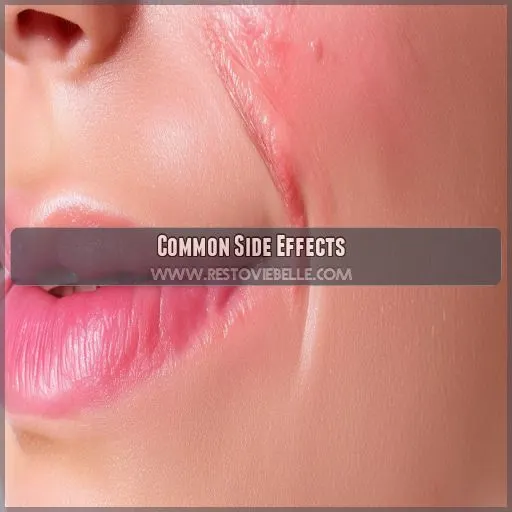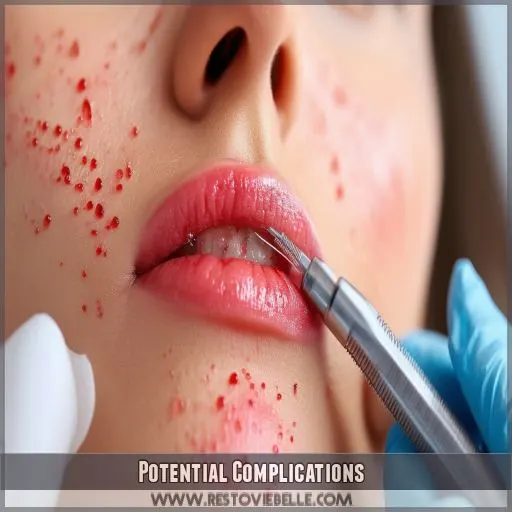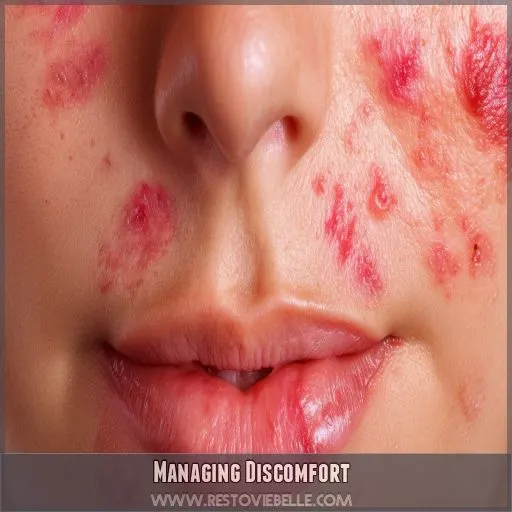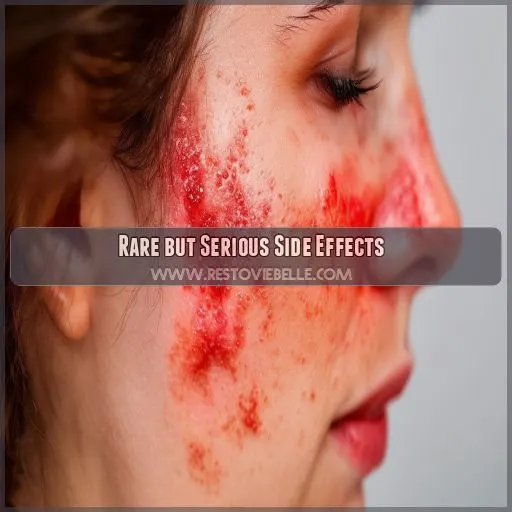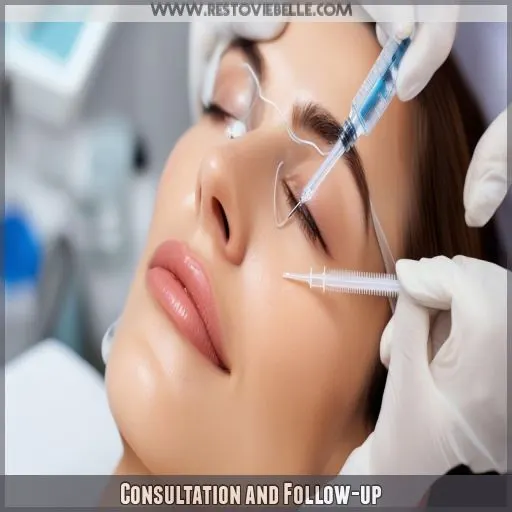This site is supported by our readers. We may earn a commission, at no cost to you, if you purchase through links.
 Envision your skin as a fine tapestry; then, microneedling would be much the same as a seamstress’s needle. Sure, it weaves rejuvenation, but could in the process be leaving temporary marks.
Envision your skin as a fine tapestry; then, microneedling would be much the same as a seamstress’s needle. Sure, it weaves rejuvenation, but could in the process be leaving temporary marks.
Understanding microneedling side effects is very important to your well-being and peace of mind. You will definitely feel common reactions like redness and swelling, but there are more serious complications that can arise.
The reason for this guide is to help you know which problems may pop up, how one manages discomfort, and when professional help should be sought.
Knowing what to expect will leave you better equipped to take on the microneedling journey.
Table Of Contents
Key Takeaways
- redness and swelling after microneedling are as common as a sunburn after a day at the beach, but don’t fret – they’re usually gone faster than you can say "rejuvenated skin"!
- While infections and scarring are about as rare as a unicorn sighting, it’s still wise to keep an eagle eye out for any unusual symptoms. Better safe than sorry, right?
- Post-treatment, treat your skin like a delicate flower – no harsh products or sun-tanning adventures for a few days. Your future self will thank you for the TLC!
- When it comes to microneedling, patience is more than a virtue – it’s your ticket to gorgeous skin. Rome wasn’t built in a day, and neither is your path to a glowing complexion!
Common Side Effects
More temporary effects after microneedling include redness, swelling, and increased sensitivity of the skin in the treated area. Common side effects usually resolve on their own in a few days, but during this time, following your practitioner’s advice is very important for proper healing and minimizing discomfort.
Redness
After microneedling, you’ll likely experience redness. This common side effect occurs as your skin reacts to the tiny punctures. Here’s what you need to know:
- Duration: Redness typically lasts 24-48 hours
- Intensity: Varies from mild pink to bright red
- Causes: Increased blood flow and minor skin trauma
Don’t worry, it’s a normal part of the healing process. To manage redness, use gentle, fragrance-free skincare and avoid sun exposure. If it persists beyond a few days, consult your provider.
Swelling
After the initial redness subsides, you’ll likely notice some swelling. This common side effect typically lasts 24-48 hours.
The causes of swelling include the body’s natural healing response and micro-injuries from the needles.
To reduce swelling, apply a cold compress and keep your head elevated. Prevention strategies include staying hydrated and avoiding alcohol before treatment.
Skin Sensitivity
After microneedling, you’ll likely experience increased skin sensitivity. Your face might feel tender to touch, and you may notice itching, dryness, or a tight sensation.
Some people even experience a temporary "purging" effect, where existing blemishes seem to surface. Bruising can also occur, especially in sensitive areas.
Don’t worry, though – these effects are typically short-lived and signal your skin’s natural healing process kicking into gear.
Potential Complications
While microneedling is generally safe, you should be aware of potential complications such as infections, hyperpigmentation, and scarring. These more serious side effects, though rare, can occur if proper precautions aren’t taken or if you have certain pre-existing skin conditions.
Infections
While infections are relatively rare with microneedling treatments, they can occur since your skin barrier is open for some period of time, making it prone to bacteria.
Be sure to sanitize well after a treatment and follow hygiene instructions provided by your practitioner. If you experience increased redness, warmth, or discharge, contact your provider right away.
In some cases, an antibiotic may be prescribed, either topical or oral.
Maintaining an overall robust immune system and practicing good skincare hygiene helps keep the risk of infection at bay.
Hyperpigmentation
There is a possibility of getting some temporary discoloration or staining of skin after microneedling. The condition isn’t pretty in its manifestations and is known as post-inflammatory hyperpigmentation. It’s usually well tolerable.
Protection from the sun is an essential means of preventing further deterioration, and topical treatments may also lend some benefit towards lightening these dark spots.
Everybody’s skin responds differently to injury, so if you do see any discoloration, one shouldn’t panic because it’s sometimes part of the healing process and is generally cleared up within a little time and good care, as mentioned above.
Scarring
Scarring—this is an uncommon but potential complication of the microneedling procedure. This procedure is intended to increase collagen synthesis, but improper technique or poor aftercare can disrupt normal wound healing. You could have:
• Elevated, red scarring (keloids)
• Depressions forming in the skin surface
- Uneven texture or pigmentation changes
• Persistent marks long after treatment
Scarring risks can be minimized by being treated by a qualified practitioner and meticulously following post-treatment instructions. You should contact your provider immediately if you find yourself noticing any kind of unusual skin change.
Managing Discomfort
One can help cope with discomfort after microneedling by applying topical creams, as advised by the practitioner, and by avoiding sun exposure for a few days following the treatment. Proper attention in the form of gentle cleansing and moisturizing after the treatment will go a long way in reducing side effects and enhancing healing.
Use of Topical Creams
This makes handling the discomfort very important. Topical creams play a very vital role here. You can feel a huge difference by applying the right creams recommended for your post-microneedling procedure.
Best practices include gentle, fragrance-free creams, such as those prescribed by the dermatologist. These creams may be soothing to irritation and reduce redness, improving healing.
Proper application won’t only enhance the results but also reduce side effects.
Avoiding Sun Exposure
This is followed with utmost care in avoiding sun exposure right after applying topical creams. Your skin is super sensitive right after microneedling—a time when safe tanning can’t be ensured.
Seek sunscreen alternatives via physical barriers like wide-brimmed hats and UV-protective clothing. If you’re going to be working outside or otherwise plan on being outside for a long period of time, seek shade protection and protect exposed areas.
Last but not least, note that using retinol further increases the sensitivity towards the sun; therefore, extra caution must be taken.
All precautions above will help your skin heal the best from the microneedling procedure to gain maximum benefit from it.
Post-treatment Care
Protect yourself from excessive direct sunlight.
After treatments, take good care of yourself to let yourself heal. For this matter, gently apply some fragrance-free light moisturizers to soothe and moisturize your skin. Add sunscreen to your daily routine even though you’ll stay at home.
Allow yourself healing time by adjusting your sleeping position so that you won’t be putting pressure on the treated areas as much as possible.
Remember that proper care can minimize discomfort and help get the best results.
Rare but Serious Side Effects
While microneedling is generally safe, you should be aware of rare but serious side effects such as allergic reactions, persistent erythema, and granulomas. These complications, though uncommon, can occur and may require immediate medical attention to manage effectively.
Allergic Reactions
Microneedling can rarely result in allergic reactions. You may experience the following symptoms:
• Sudden irritation or inflammation of the skin
• Hives or itchy rash
- Face or throat swelling
• Difficulty catching breath
If you experience these symptoms report for immediate medical attention. Allergic reactions may range between mild to very serious; anaphylaxis is the worst outcome of all. It is, therefore, important to inform your practitioner of any allergies before treatment in order to avert the risks.
Persistent Erythema
One of the rare but potentially worrying side effects pertaining to microneedling is persistent redness or prolonged erythema. You may well be used to this feeling if you have conditions such as rosacea or just really sensitive skin. It’s hence important to look after your skin’s reaction in the aftermath of treatment and seek professional advice if you still feel redness beyond the treatment’s expected healing period.
| Symptom | Duration | Action |
|---|---|---|
| Mild redness | 1-3 days | Normal; monitor |
Moderate redness
Granulomas
While persistent erythema can be troubling, granulomas are another rare but serious side effect to be aware of. These small, inflammatory nodules form when your immune system reacts to foreign substances. To understand granuloma formation:
- They’re your body’s defense mechanism gone awry
- They can appear weeks or months after treatment
- They’re often painless but may cause discomfort
- They require professional medical attention
If you notice any unusual lumps, consult your dermatologist immediately for proper assessment and treatment protocol.
Consultation and Follow-up
Before undergoing microneedling, you’ll need a pre-treatment assessment to determine your suitability and discuss potential risks. After the procedure, your practitioner will provide post-treatment monitoring and guidance, and you should seek professional advice if you experience any concerning side effects.
Pre-treatment Assessment
Before undergoing microneedling, you’ll have a pre-treatment assessment. Your provider will review your patient history, evaluate your skin type, and discuss your expectations. This crucial step helps identify potential risks and tailor the treatment to your needs.
Be honest about any medical conditions, medications, or previous skin treatments.
Your provider will also explain the procedure, potential side effects, and aftercare instructions to ensure you’re fully informed and prepared.
Post-treatment Monitoring
Right after the microneedling treatment, monitor the progress of your skin. You’ll be required to:
• Record changes in skin texture and tone
• Assess the healing process on a daily basis
• Assess your level of satisfaction with the results overall
Monitor your skin response and changes closely, reporting any concerns. Schedule follow-up appointments for checking healing and optimization of results. Monitoring along the way allows potential problems to be picked up earlier than would otherwise be possible and allows time to make adjustments to your post-treatment care.
Seeking Professional Advice
It’s important to know when you need professional advice after monitoring how well your treatment is going. Your practitioner should understand that they’re to give clear post-treatment instructions and set realistic expectations on the very first day.
Even if you have any unusual symptoms or some doubts, don’t hesitate to contact them. For perfect results, there needs to be long-term monitoring.
While attending a microneedling session, proper patient selection and informed consent at the beginning are vital for both the doctor and the patient. Your safety and satisfaction are the top priorities.
Frequently Asked Questions (FAQs)
How long does redness last after microneedling?
You’ll typically experience redness for 24-48 hours after microneedling. It’s your skin’s natural response to the treatment. Don’t worry, though – it’s temporary! Most people see their skin return to normal within a few days.
Can I wear makeup after a microneedling session?
You shouldn’t wear makeup immediately after microneedling. Give your skin time to heal, typically 24-72 hours. When you do apply cosmetics, use clean brushes and gentle, non-irritating products. Your skin’s sensitivity may vary, so listen to your body.
Is microneedling safe for all skin types?
Microneedling’s generally safe for most skin types, but it’s not one-size-fits-all. You’ll want to consult a dermatologist, especially if you’ve got sensitive skin or certain conditions. They’ll assess your skin and recommend the best approach for you.
How often should I repeat microneedling treatments?
You should space out microneedling treatments every 4-6 weeks. This allows your skin to fully heal and regenerate between sessions. Consistency is key, but don’t overdo it. Listen to your skin and consult your dermatologist for personalized advice.
Does microneedling hurt more than other skin treatments?
You’ll feel some discomfort during microneedling, but it’s generally less painful than more invasive treatments. Most describe it as a prickling sensation. Topical numbing creams can help, making it bearable for most people.
Conclusion
Microneedling can work wonders, but it comes with risks. Now, you deeply understand the microneedling side effects—from common reactions to rare complications.
Thus, armed with this knowledge, you’ll be better placed to make informed decisions on how to manage the discomfort. After all, proper care and professional guidance are the pathways to successful treatment.
If you have unusual symptoms, don’t hesitate to seek medical advice. By using the correct approach, you’ll be able to realize the rejuvenation potential of your skin by taking a microneedling journey in a safe and effective way.

